Table of contents
- On the way: Montenegro – Balkans Out and about in Montenegro: the call of the black mountains
- Out and about in Montenegro
- Info
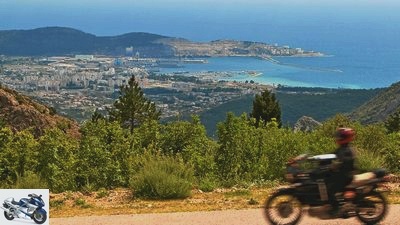
Hess, Schmitz
to travel
On the way: Montenegro – Balkans
On the way: Montenegro – Balkans
Out and about in Montenegro: the call of the black mountains
While scratching a curve, Angela Schmitz and Axel Heb take a few superlatives with them from Europe: the longest and deepest gorge, one of the oldest remaining primeval forests and the largest lake on the Balkan Peninsula.
Angela Schmitz
08/16/2012
Out and about in Montenegro
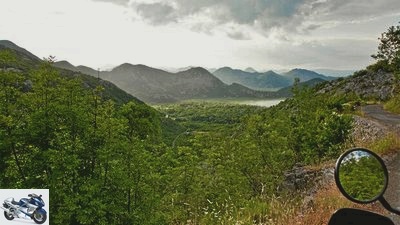
Schmitz, Hess
Crna Gora shines in a rich green.
No sooner have we driven the motorcycles off the ramp of the car train in Villach in the morning of the Lord when threatening black clouds hang over us. They pull with us over the Wurzenpass, where we can only shake them off after a heavy downpour. At 25 degrees the air steams, we tear our rainwear off. Sun and wind awaken our spirits. Thanks to the constant change in weather, the Balkans drowned in luscious colors from here on – a spectacle for the lens. Deep green meadows, turquoise rivers. Brown cows chew on the grass peacefully in the pastures, canoeists conquer the wild waters. While hordes of motorcycle groups are still approaching us in Slovenia, the crowd loses the further south we travel.
Buy complete article
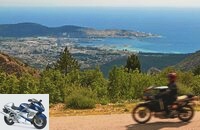
On the way: Montenegro – Balkans
Out and about in Montenegro: the call of the black mountains
8 pages) as PDF
€ 2.00
Buy now
From Montenegro we only come across a handful of motorized two-wheelers, and most of them have Southern or Eastern European license plates. So we only share the spectacular bend routes with cars, trucks and mobile homes, which is tough. Upon entry, the customs officer gives us an information sheet with statistics on traffic accidents for our friendly attention. According to the theory, the accident rate increases immensely every two weeks when changing beds in the tourist strongholds. Practical experience later makes these references look ridiculous. Policemen with laser pistols lurk in many corners of the country, and they seem to be making plenty of prey. But if a local is caught, in case of doubt they will know someone who knows someone who is already taking care of everything with the police. So it is the foreigners who are most wages. Those who adhere to the regulations are a real obstacle to traffic, because the speeders stick to the rear tire. More than once we only narrowly escape the breakneck overtaking maneuvers of the Montenegrins. When the locals are not out and about in their vehicle, they turn out to be kind-hearted and helpful. 625,000 people live together peacefully in this small country and form a colorful mix of peoples of Montenegrins, Serbs, Albanians, Croats, Roma and Kosovars.
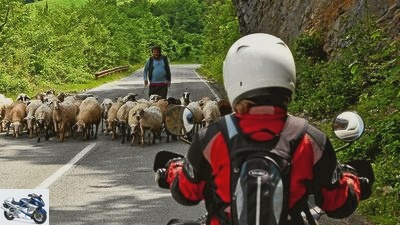
Schmitz, Hess
On the country roads, the issue of right of way is often regulated by majority voting.
In the Bay of Kotor we set up our first night camp in the country and enjoy the seclusion and tranquility. If you want, you will come across some historical traces in this area, such as in Perast with the monastery islands and dilapidated palazzi made of the natural stones characteristic of this area. The old town of Kotor is already some millennia under its belt, but was pretty much destroyed by an earthquake in 1979. The UNESCO then designated the old town center as a World Heritage Site, and many buildings could be repaired with time and money. We climb a hill on the eastern edge of the four-kilometer-long city wall over 1,348 steps. 260 meters further up we look from the fortress Sv. Ivan across the bay. In our backs a donkey path meanders around boulders of the Karst mountains and around lonely huts, formerly the only connection to the hinterland where people still live with their goat herds. Downstairs I taste the excellent local mountain cheese and Njegu ?? ki pr ?? ut, a smoked ham, at a market stall. The friendly man wants to explain to me how cheese and ham are made, the communication is lacking, but with a few scraps of Montenegrin words and hands and feet we understand each other.
Our onward journey is delayed by a thunderstorm. In a matter of minutes, black rain clouds with lightning and thunder pull into the bay, hailstones the size of a thumbnail patter on the pavement – and transform the GPS on the motorcycle into an aqua-
rium. We fall back on something that has almost been forgotten but has been tried and tested: maps. Wet prospects for the next few days drive us instead of into the mountains further down the coast towards Lake Skadar.
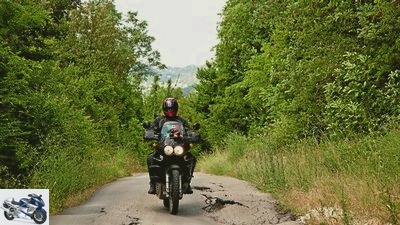
Schmitz, Hess
Minor road warps after prolonged exposure to summer heat.
In Virpazar we meet Toman Zec, one of a kind. Just like the museum under the roof of his small hotel. Here he has collected family items from three centuries. He knows a story to tell about every piece. Just like the photo and hat collection in the dining room of the oldest existing restoration in Montenegro. He tells me with a little sadness that more and more young people are leaving the region to seek their fortune in the cities. From the previous 8,000 residents, there are now barely 800 left, mostly older ones. He points over to the market square, where three market women offer their self-pressed olive oil, goat cheese and a few crops for sale. “A few years ago, dozens of stalls crowded here on market day and people came from all over to shop, but those days are long gone.” He turns around and goes back to his collection of herbs, which he cherishes and tends. He delights every female guest with a sachet of dried herbs or a sprig of flowers. I transported my fragrant collection home safely in an aluminum case. For dinner, my palate enjoys the fresh catch from the turquoise sea, the trout tastes great. I also taste a red wine from local production, a very good drop. A few years ago, investments were made in the area in viticulture. This opened up a new source of income for the residents and saved the last villages from giving up.
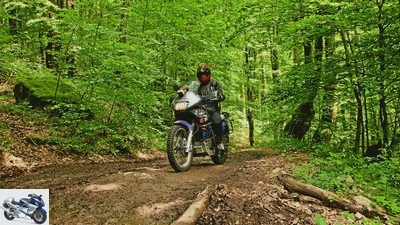
Schmitz, Hess
In the woods around Biogradska Gora, the Honda feels in its element.
For a trip to Lake Skadar, we choose the wine route, the winding course of which is also often used as a racing track, as evidenced by the white and red painted car tires in the tight bends and the painted start and finish line on the asphalt. Finally, we follow the narrow coastal road that gently curves 40 kilometers along the slope to the Skadar Lake, which is the youngest natural freshwater reservoir in Europe and is only 1000 years old.
As luck would have it, we met Ratko, a Montenegrin from the Rhineland, on the car train. On the way to the Durmitor massif, we discover his motorcycle in a small village – we are very happy to see you again! He is visiting his sister and we are sitting in the sun with her. The sister tells us about the difficult living conditions here in the rural regions of the country, which at first glance seem so idyllic to us. Behind the scenes, the reality is pretty tough. Although people live in their own modest four walls and have electricity and running water, many 40-year-olds are still dependent on their parents’ financial drips. Youth unemployment is high. There is no social security, if a company goes bankrupt, those laid off have to watch how they get along. After a long working life, a monthly pension of only 350 euros remains.
We arrange to meet Ratko for the next day in the mountains and make our way there. In abljak we go looking for a room. But the prices in this ski resort are high. Spontaneously someone at a hotel reception offers us to spend the night in his house for a small fee. A little later we settle in comfortably in a room at his home, just in time before the next rain shower comes down and lasts until the next morning.
Ratko takes us to his home village, where only a handful of families still live. “What do the people live on here?”, I ask him. They harvest their vegetable patches, pick mushrooms on the steep slopes, and every now and then they slaughter one of their animals from the small herd that they graze in the meadows. We make our way from the village through dense undergrowth to the Tara Gorge, which is one of the uniqueness of the landscape in the region.
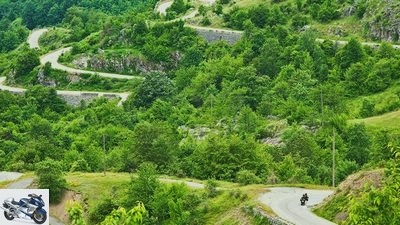
Schmitz, Hess
Montenegro is not stingy with dreamlike curved landscapes, as here in the Komovi Mountains.
Suddenly we hold our breath: the steep rock faces fall almost 1,300 meters down towards the Tara, which paves its way from the ijovo mountains near Kola in its water bed 140 kilometers to the confluence with the Piva on the Bosnian border. One step too far to the edge and no one would ever find me again. I hear my heartbeat But it is drowned out by the mighty echo of the rushing river against the karst rock. The next day, the view into the gorge from a 150 meter high bridge is a little less spectacular. The seller at a kiosk in the neighboring parking lot shows me a postcard with an old photo of the building and explains the historical ground we are standing on. The five-arched construction served the partisans as a strategic point in the early 1940s. When German and Italian troops advanced into the area, the partisans unceremoniously blew up one of the arches of the recently completed bridge and prevented the enemy from marching on.
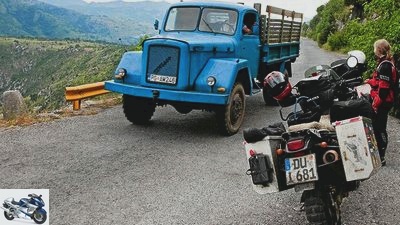
Schmitz, Hess
Biggest rush hour on a branch line north of Podgorica.
From Kola? In, we spontaneously decide to drive around the Biogradska Gora National Park using a thin white line on the map and stumble over roots and stones on the unpaved road in twos on a machine. However, once we don’t make it all the way around, a local warns us that ice and snow are blocking the way at high altitudes. So we content ourselves with another superlative and hike through one of the last primeval forests in Europe. Montenegro was the first European country to write environmental protection in its constitution. There are good approaches to preserving the pearl, even if the acrid smoke of burning wild garbage dumps steals the air here and there or natural fillet pieces fall victim to real estate sharks.
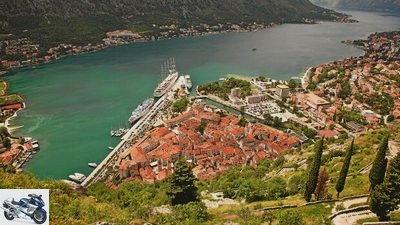
Schmitz, Hess
Over the roofs of the old town of Kontor, your gaze wanders far into the bay of the same name.
In countless bends and bends we make our way over narrow country roads through the rough landscape. When the valley north of Podgorica spreads in front of me, coming from the mountains, I have the feeling for the blink of an eye that the world is at my feet. The next moment I hit the handlebars just in time for the next hairpin bend. Over the pass of the Loven National Park we finally tumble in 25 switchbacks down to the coast. The route around the inner bay of Kotor can be shortened by ferry, then it is only a few kilometers to the border. Beyond the Alps, thunderstorms, storms and rain await us again, which will remain true to us right up to our front door. Actually a reason to turn around immediately and to turn your back on the gray everyday life.
Info
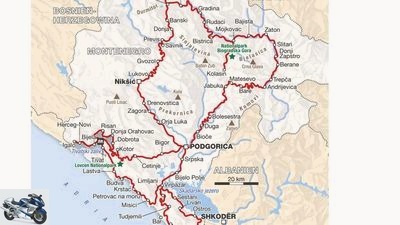
Werel
The driven Balkan tour through the black mountains of Montenegro.
Montenegro is overwhelming with its scenic, cultural, historical and culinary charms. In addition, there is the hospitality of the uncomplicated locals.
Numbers and dates
Travel time: 3 weeks
Distance covered: 4,630 kilometers, including 1024 kilometers in Montenegro in ten days
Montenegro
Capital: Podgorica
Area: 13 812 km²
Foundation: June 3, 2006
Currency: Euro
Population: 625,000
Worth seeing:
The country is still a paradise for motorcyclists who are looking for secluded bends. In the mountains in particular, you will discover small country roads where you will hardly meet anyone. Through traffic mostly uses the wide, newly built country roads in many places. Many routes are paved, but there are also unpaved slopes. The driving pleasure is only spoiled by the countless traffic policemen with their laser pistols who can lurk around every corner.
Montenegro has some highlights that are worth seeing: the Tara Gorge, the national parks Biogradska Gora, Lovcen and Durmitor, Lake Skadar on the Albanian border, the historic cities of Kotor, Perast or Cetinje, countless monasteries, churches and mosques.
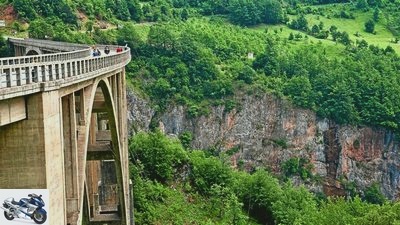
Schmitz, Hess
The arch bridge at Moikovac was blown up shortly after completion, but has now been repaired.
Entry / overnight stay:
An identity card is sufficient for entry. The green insurance card is required for the motorcycle. Since the country had already introduced the Deutsche Mark as the official currency in 1999, it adopted the euro as the official currency in 2002. However, Montenegro is not allowed to mint its own coins as it is not a member of the European Monetary Union. However, the country is a candidate for EU membership.
To stay overnight, you spontaneously take advantage of one of the numerous Sobe or Apartmani offers – private rooms or apartments that are available all over the country. In Montenegro, travelers will also find a place to pitch their tent in many places, but more on the coast than in the hinterland.
Of course there are also hotels of various categories, the best thing to do is to look for accommodation that suits your taste. During the main holiday season in July / August, however, it can get crowded in the tourist coastal region.
Many locals speak a little German, the younger ones more English, or you can communicate with your hands and feet. That almost always works without any problems and creates nice contact.
Literature / Maps:
The Guide “Montenegro” by Achim Wiegand (Michael Muller Verlag) provides interesting information about the country and its people as well as good travel tips, spiced with dry humor. Recommended as cards: “Montenegro” from Freytag & Berndt, scale 1: 150000; “Croatia coast” from Freytag & Berndt, scale 1: 200000; “Slovenija auto map”, Scale 1: 300,000. Maps are best bought on the go at kiosks or petrol stations near the respective borders.
Related articles
-
Daams to travel Montenegro Montenegro Phoenix from the ashes The southernmost fjord, the deepest canyon and one of the last primeval forests in Europe ??…
-
Johannes Muller 32 pictures Johannes Muller 1/32 There: From the highest peak of Corfu, the Pantocrator, you can see the Greek-Albanian border. Johannes…
-
Encounters on a trip to the Balkans
Blacksmith to travel Encounters on a trip to the Balkans Encounters on a trip to the Balkans Europe extreme Eleven days, ten countries, 5825 kilometers,…
-
Bulgaria with the highest mountains in the Balkans
Deleker to travel Bulgaria with the highest mountains in the Balkans On the way: Bulgaria The highest mountains of the Balkans as a travel destination…
-
to travel Slovenia Slovenia In all silence The charm of Slovenia is only revealed on side roads, the smallest streets and gravel roads. And the best…
-
Andreas Hutter to travel Mongolia Mongolia In the first walk through the steppe An adventurer and photographer from Switzerland sets off on a trip…
-
With the motorcycle in Sweden – Lapland
Lundgren to travel With the motorcycle in Sweden – Lapland The gravel paradise for enduros With the motorcycle in Sweden – Lapland Sweden is a sparsely…
-
Photos: Obert to travel South and Central Asia South and Central Asia Around the roof of the world It’s hard to believe, but the idea came spontaneously…
-
On the way: Readers’ trip to the Carpathians
Kaitinnis 10 pictures Kaitinnis 1/10 The magnificently decorated Sucevita Monastery. Kaitinnis 2/10 A local Hutsul in festival costume. Kaitinnis 3/10…
-
Daams to travel On the way: Bulgaria On the way: Bulgaria Europe’s back Bulgaria has more to offer than cheap package holidays on the beaches of the…